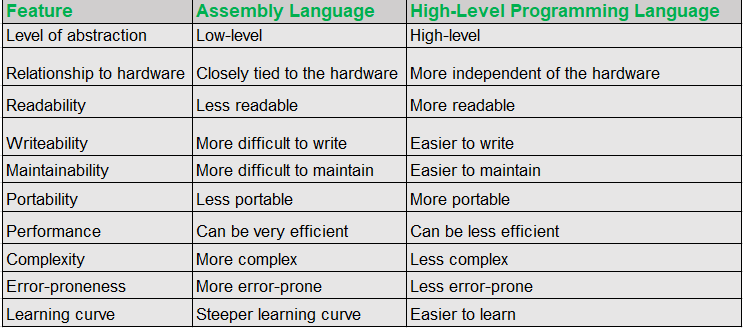Assembly Language Vs. High-Level Language
Assembly language operates at a low level of abstraction, providing direct access to a computer's hardware and precise control over the central processing unit (CPU) and memory, making it suitable for tasks that demand fine-grained hardware manipulation and optimization. However, it is architecture-specific, less portable, and requires in-depth understanding of hardware. High-level programming languages, in contrast, offer higher-level abstractions and a more user-friendly development environment, promoting productivity and code readability.

While they sacrifice some low-level control and efficiency, high-level languages are often more portable and less challenging for debugging. The choice between assembly language and high-level languages depends on the project's specific requirements, balancing control, efficiency, and development productivity.
Here is a more detailed explanation of the key differences:
Level of abstraction
Assembly language is a low-level language, which means that it is closely tied to the underlying hardware. Assembly language instructions correspond directly to machine code instructions, which are the instructions that the computer's processor understands. This makes assembly language very efficient, but it also makes it more difficult to write and maintain.
High-level programming languages are more abstract than assembly language. This means that they are less tied to the underlying hardware, and they use more human-readable constructs, such as variables, loops, and conditional statements. This makes high-level programming languages easier to write and maintain, but it can also make them less efficient than assembly language.
Relationship to hardware
Assembly language is closely tied to the hardware of a particular computer. This means that assembly language code written for one computer may not work on another computer with a different hardware architecture.
High-level programming languages are more independent of the hardware. This means that high-level language code can be compiled for different hardware platforms, making it more portable.
Readability
Assembly language is less readable than high-level programming languages. This is because assembly language code is written in mnemonics and labels, which are not as easy to understand as the human-readable constructs used in high-level programming languages.
Writeability
Assembly language is more difficult to write than high-level programming languages. This is because assembly language code is more verbose and requires more attention to detail. High-level programming languages are easier to write because they use more human-readable constructs and provide more error-checking.
Maintainability
Assembly language is more difficult to maintain than high-level programming languages. This is because assembly language code is more tightly coupled to the hardware and is less abstract than high-level language code. Changes to the hardware can require significant changes to assembly language code, while changes to high-level language code can often be made with less effort.
Portability
Assembly language is less portable than high-level programming languages. This is because assembly language code is tied to a specific hardware architecture. High-level language code can be compiled for different hardware platforms, making it more portable.
Performance
Assembly language can be very efficient, as it directly translates into machine code. This makes assembly language a good choice for writing code that needs to be very fast, such as device drivers and operating system kernels.
High-level programming languages can be less efficient than assembly language, as they require additional steps to be translated into machine code. However, high-level programming languages are often optimized by compilers, which can improve their performance.
Complexity
Assembly language is more complex than high-level programming languages. This is because assembly language requires a deep understanding of the underlying hardware, and it can be difficult to read and write. High-level programming languages are less complex and easier to learn, as they use more human-readable constructs and provide more error-checking.
Error-proneness
Assembly language is more error-prone than high-level programming languages. This is because assembly language code is more verbose and requires more attention to detail. High-level programming languages are less error-prone because they use more human-readable constructs and provide more error-checking.
Learning curve
Assembly language has a steeper learning curve than high-level programming languages. This is because assembly language requires a deep understanding of the underlying hardware, and it can be difficult to read and write. High-level programming languages are easier to learn, as they use more human-readable constructs and provide more error-checking.
Conclusion
Assembly language and high-level programming languages are both valuable tools for programmers. Assembly language is a powerful tool for writing code that is highly optimized, portable, or secure. High-level programming languages are easier to write and maintain, and they are more portable than assembly language. The choice of which language to use depends on the specific needs of the programmer and the project.